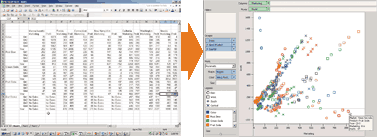LESSON - Five Ways Data Warehouses Can Promote Visual Problem-Solving
By Dan Everett, Product Marketing, Hyperion Solutions Corporation
Ask a group of executives whether they consider themselves visual thinkers, and most will answer “Yes,” excited you’ve divined one of their core character strengths. Visual thinking is one of the most powerful ways to solve problems.
It’s unfortunate, then, that popular business intelligence products do so little to embrace visual analysis. Most reporting and analysis products suffer from five fundamental visual design flaws that defeat problem solving. This article will discuss these flaws and introduce best practice solutions.
1. Show Multi-Dimensional Relationships
The effectiveness of data warehouses is ultimately constrained by the success of their interfaces. Yet most interfaces struggle to present even two or three dimensions of a business problem effectively. To be effective, interfaces should be designed to display multi-dimensional problems to business people in a compelling way.
2. Provide Customizable Views of Business Problems
Software vendors like to boast about the large number of canned charting templates in their reporting packages. Yet no number of templates is sufficient to provide all business users with answers to all of their particular questions. The best practice solution to such problems is to give people the ability to easily build custom views using a front-end interface with drag-and-drop functionality, to create the visual analyses they need to answer the particular questions of their departments—without being constrained by templates.
3. Combine Querying and Visual Analysis into a Unified Process
Most data warehouse deployments separate the process of querying a database from the process of visualizing results. That is, problem solvers must generate queries and then conduct one-off visual analyses using a charting wizard. Hours pass before even a few basic business questions are answered. People can’t answer a series of questions if the process of creating a view of data is divorced from the process of retrieving records.
The best practice solution to this problem is to use software interfaces that unite querying and visual analysis into a single process. In these deployments, dragging and dropping data fields automatically produces both the queries and the visual results needed to progress to the next stage of analysis, enabling users to focus on the visual layouts without distracting details.
4. Support Visual Data Extraction
A considerable portion of end-user business questions involve the extraction of data. Unfortunately, most reporting and analysis front-ends suffer from a shortcoming that makes data extraction time-consuming: they separate visual analysis from data extraction. If end users are not able to “reach out and grab” data that interests them, they can’t leverage the full power of databases for their daily workflow.
The solution is to deploy interfaces that support visual extraction, selecting records or tuples from a graphical view of data and exporting them directly to another application (i.e., Excel). This type of interaction dramatically improves the productivity of knowledge workers.
5. High-Performance Warehouse
The performance of a visual analysis system is ultimately determined by the performance of enterprise data stores. All of the visual analysis best practices outlined here, for instance, require data sources fast enough for interactive analysis. Characteristics of a high-performance data store that can support visual analysis include scalability, query response, query predictability, and refresh latency.
Conclusion
Software interfaces that facilitate visual problem solving are becoming a successful new addition to business intelligence deployments worldwide. The common theme of successful solutions is that they enable real-time “visual analysis sessions” with data. A first view not only provides an insight (“Costs are increasing”), but also suggests additional questions (“Which products are responsible for the increase?”). Successful deployments enable people to interact immediately with the first picture required for visual problem solving at the speed of thought.

“Hyperion Visual Explorer is not just a slick way to visualize; it’s a slick way to visually analyze." Wayne Eckerson, TDWI
This article originally appeared in the issue of .